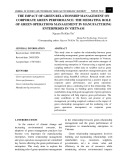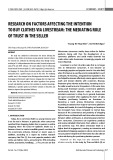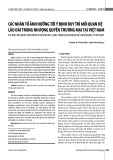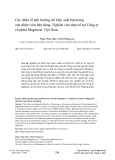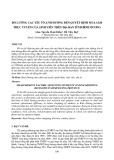
THUONGMAI UNIVERSITY
FACULTY OF ENGLISH
------------------------------- -------------------------------
PRINCIPLES
OF BUSINESS COMMUNICATION
Hanoi, 2019

Pr i nci pl es of bu si ness commu ni ca t i on
---------------------------------------------------------------------------------------------------------------------
1
UNIT 1
AN INTRODUCTION TO COMMUNICATION
I. Definition of communication
There are many definitions of communication posed by different writers. According to
Dwyer (2000: 4), “Communication is the transfer of meaning. Communication is any behavior,
verbal or nonverbal, that is perceived by another. Knowledge, feelings or thoughts are encoded
and sent from at least one person and received and decoded by at least one other. Meaning is
given to this message as the receiver interprets the message. A connection is made between the
people communicating. Communication lets us learn more about ourselves and the world around
us, share experiences with others, persuade and influence others, and relax and enjoy ourselves.”
Verderber, R.F. , Verderber, K.S. & Berryman- Fink, C. (2008) define “Communication is the
process of creating or sharing meaning in informal conversation , group interaction, or public
speaking”. Another definition is set by Hybels, S & Weaver II, R.L. (1992). According to them,
“Communication is any process in which people share information, ideas and feelings. That
process involves not only the spoken and written word, but also body, personal mannerisms and
style, the surroundings- anything that adds meaning to a message.”

Pr i nci pl es of bu si ness commu n i ca t i on
---------------------------------------------------------------------------------------------------------------------
2
From these definitions, it can be summarized that Communication is the process of
sending and receiving information among people. It is a way of reaching others by transmitting
ideas and thoughts, feeling and values.
II. The importance of communication
Ancient Greeks considered communication to be important for the social cohesion and
democracy. Evidence to this are the creation of the ancient market, the establishment of theatres
etc. where people used to meet, exchange information and goods and where they had the
opportunity to send and receive knowledge and ideas. Several philosophers and prominent
dramatic writers dealt with the communication as a form of teaching. Socrates, the philosopher,
has been a warm supporter of verbal word and the founder of the “dialectic theory”. He was the
first to realise the significance of communication for the youth’s and the citizen’s education. In
one of his dialogues with Protagoras he noted the verbal word’s power by saying: “I heard (…)
that you are capable of speaking on your own or even teaching other people by saying a lot of
things about the same subject in order that the dialogue won’t ever finish and no one will ever say
less than you do”.
Gorgias, the thinker, answering Socrates’ question, says the most important good is the art
of persuasion giving the following arguments: “What I say is that the most important good is the
ability to persuade everybody: the judges in the court, the members of the parliament, the citizens
in a public meeting and anyone who takes part in a gathering”.
Several surveys have shown that communication is the key to human relationships and
the key to social groups.
Communication and information play an important role in the creation of
preconditions for peace, dignity, justice, disarmament and solving of universal problems,
(Howard, 1995).
Everyone needs communication skills
People fulfill a variety of needs through communication, and communicating effectively
can provide considerable pleasure. A stimulating conversation, participation in a group discussion

Pr i nci pl es of bu si ness commu n i ca t i on
---------------------------------------------------------------------------------------------------------------------
3
Communication
is an interactive
process
that leads to solving a problem, a persuasive speech that gains signatures on a petition: all these
are instances of successful communication.
Even though we have been communicating since birth, we are not always effective.
Sometimes communication does not work and we end up frustrated. We get lost from incomplete
directions, insult a friend with what we intended as an innocent comment, or bore an audience
with a speech. Effective communication is a problem for many of us; that is why a barrage of
books, articles, and seminars tell us how to
communicate.
Communication is vital in all areas of our
lives. We use it for persuasion; to influence
relationships; to inform; to share; to discover, and
uncover information. We want a friend to stop
studying and go to a party; we want our friends
and family to like one another; we want someone
to join our club or to vote for a participant
candidate.
Perhaps our most important need is to
maintain and improve relationships. Through
communication we discover others’ needs and
share our own. Any kind of relationship requires
open and accurate lines of communication. Only
when such lines exist will people feel free to voice important thoughts and feelings.
Communication, then, is vital to our lives. To live is to communicate. To communicate
effectively is to enjoy life more fully.
III. Communication process
Communication has been deemed as a process. The term
“process” refers to identifiable flow of information through
interrelated stages of analysis directed toward the achievement of an
object. In the case of social action, the concept of process is dynamic rather than stative in which
"The world of business is a world of
act ion. Product s are designed, made,
and sold. People are hired. Services
are rendered. Policies are devised and
implement ed. Jobs are learned and
performed. Yet t here is no pract ical
way in which any of t hese event s can
t ake place wit hout communicat ion."
---Communication expert
Harold Janis
---

Pr i nci pl es of bu si ness commu n i ca t i on
---------------------------------------------------------------------------------------------------------------------
4
events and relationships are seen as dynamic, continuous and flexible. Dwyer (2000) states that
the process of communication is dynamic and interactive. Someone sends, someone receives and
in between there is a message. As information flows, people place meaning and structure on the
variety of messages received from others.
The communication process is a simple model that demonstrates all the factors that can
affect communication. Communication is effective if the message that is received is the same one
that is sent.
The communication process takes place in various situations for different reasons, with
the potential for many interpretations. It has seven main elements.
1. Sender: the person who has something to communicate
2. Message: what needs to be communicated
3. Receiver: the person who will receive the message
4. Feedback: the receiver's response to the attempt by the sender to send the message
5. Channel/ Medium of transmission: the means of communication
6. Context or setting: circumstances within which communication takes place
7. Interference or noise: stimuli that interferes with communication process
There are many models of the communication process. The figure presented is
presentation of how communication works. It should be stressed that it cannot be a complete
guide; it takes the most significant elements of the process and place these in a useful sequence.
Figure 1.1: Communication process
Channel
Receiver
Context
Feedback
Message
Encoding
Decoding
Sender

![Kế hoạch hoạt động Marketing thương hiệu [chuẩn nhất]](https://cdn.tailieu.vn/images/document/thumbnail/2025/20251102/babyzun486877@gmail.com/135x160/14481762151982.jpg)

![Bài giảng Ứng dụng đa phương tiện trong kinh doanh [mới nhất]](https://cdn.tailieu.vn/images/document/thumbnail/2025/20250805/cunlove4392/135x160/75211754378787.jpg)
![Đề cương chi tiết học phần Giao tiếp trong kinh doanh [chuẩn nhất]](https://cdn.tailieu.vn/images/document/thumbnail/2025/20250725/ttu591805@gmail.com/135x160/41141753760021.jpg)

